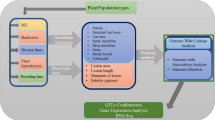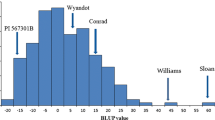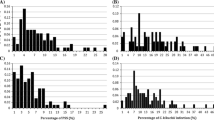Abstract
The frequency of soybean white mold (Sclerotinia sclerotiorum, SWM) outbreaks has increased since 1978, and this disease is currently considered to be the second most important cause of soybean yield loss worldwide. We have studied SWM in stems of soybean cultivar Maple Arrow, which shows partial resistance to SWM, in an attempt to identify the quantitative trait loci (QTLs) underlying soluble pigment(s) content, which is associated with SWM resistance. A SWM-susceptible cultivar, Hefeng 25, was crossed with Maple Arrow, and 149 F5:6 recombinant inbred lines were subsequently advanced through single-seed-descent. A total of 109 simple sequence repeat (SSR) markers were used to construct a genetic linkage map. Three QTLs for soluble pigment content in soybean stems associated with the resistance to SWM, namely, Qsp-1 (Satt502-Sat_159), Qsp-2 (Sat_156-Satt251), and Qsp-3 (Satt525-Satt233), were identified in 2007 and 2008 and located onto linkage groups D1a+q, B1 and A2, respectively. The phenotypic variation (R 2) explained by these QTLs ranged from 6.29 to 15.37%. These three QTLs were not significantly related to known QTLs associated with escape resistant mechanisms. The use of these QTLs in marker-assisted selection may contribute to improved soybean resistance to SWM.


Similar content being viewed by others
References
Arahana VS, Graef GL, Specht JE, Steadman JR, Eskridge KM (2001) Identification of QTLs for resistance to Sclerotinia sclerotiorum in soybean. Crop Sci 41:180–188
Basten CJ, Weir BS, Zeng ZB (1996) QTL cartographer. North Carolina State University, Raleigh
Beavis WD (1998) QTL analyses: power, precision, and accuracy. In: Paterson AH (ed) Molecular dissection of complex traits. CRC Press, Boca Raton, pp 145–162
Biehn WL, Kuc J, Williams EB (1968a) Accumulation of phenols in resistant plant-fungi interactions. Phytopathology 58:1255–1260
Biehn WL, Williams EB, Kuc J (1968b) Fungitoxicity of phenols accumulating in Glycine max–fungi interactions. Phytopathology 58:1261–1264
Blum A, Klueva N, Nguven HT (2001) Wheat cellular thermo tolerance is related to yield under heat stress. Euphytica 117:117–123
Boland GJ, Hall R (1986) Growth room evaluation of soybean cultivars for resistance to Sclerotinta sclerotiorum. Can J Plant Sci 66:559–564
Boland GJ, Hall R (1987) Evaluating soybean cultivars for resistance to Sclerotinia sclerotiorum under field conditions. Plant Dis 71:934–936
Chun D, Kao LB, Lockwood JL, Isleib TG (1987) Laboratory and field assessment of resistance in soybean to stem rot caused by Sclerotinia sclerotiorum. Plant Dis 71:811–815
Churchill RW, Doerge GA (1994) Empirical threshold values for quantitative trait mapping. Genetics 138:963–971
Cline MN, Jacobsen BJ (1983) Methods for evaluating soybean cultivars for resistance to Sclerotinia sclerotiorum. Plant Dis 67:784–786
Cregan PB, Jarvik T, Bush AL, Shoemaker RC, Lara KG, Kahler AL, Kaya N, VanToai TT, Lohnes DG, Chung J, Specht JE (1999) An integrated genetic linkage map of the soybean genome. Crop Sci 39:1464–1490
Deikman J, Hammer PE (1995) Induction of anthocyanin accumulation by cytokinins in Arabidopsis thaliana. Plant Physiol 108:47–57
Delaney DE, Graef GL, Rutledge S, Power K, Higgins B, Steadman JR, Diers B (1997) Mapping QTL associated with Sclerotinia stem rot resistance in soybean (abstract). Poster presented at Plant and Animal V, San Diego
Donaldson PA, Anderson T, Lane BG, Davidson A, Simmonds DH (2001) Soybean plants expressing an active oligomeric oxalate oxidase from the whieat gf-2.8(germin) gene are resistant to the oxalate-secreting pathogen Sclerotina sclerotiorum. Physiol Mol Plant P 59:297–307
Doyle JJ, Doyle JL (1990) Isolation of plant DNA from fresh tissue. Focus 12:13–15
Fernando WGD, Ramarathnama R, Krishnamoorthyb AS, Savchuka SC (2005) Identification and use of potential bacterial organic antifungal volatiles in biocontrol. Soil Biol Biochem 37:955–964
Gondran J, Leclercq P (1993) Genetic variability of soybean for resistance to Sclerotinia sclerotiorum (Lib) de Bary. Statistical relationship with some traits of the crop. Agronomy 13(2):85–94
Grau CR (1988) Sclerotinia stem rot of soybean. In: Wyllie D, Scott DH (eds) Soybean diseases of the North Central region. American Phytopathological Society, St. Paul, pp 56–149
Grau CR, Radke VL (1984) Effects of cultivars and cultural practices on Sclerotinia stem rot of soybean. Plant Dis 68:56–58
Grau CR, Radke VL, Gillespie FL (1982) Resistance of soybean cultivars to Sclerotinia sclerotiorum. Plant Dis 66:506–508
Grau CR, Dorrance AE, Bond J, Russin J (2004) Fungal diseases. In: Boerma HR, Specht JE (eds) Soybeans: improvement, production and uses, 3rd edn. Agronomy Mongraph 16. ASA, CSSA, and SSSA, Madison, pp 679–763
Guo XM, Wang DC, Gordon SG, Helliwell E, Smith T, Berry SA, Martin SK, Dorrance AE (2008) Genetic mapping of QTLs underlying partial resistance to Sclerotinia sclerotiorum in soybean PI 391589A and PI 391589B. Crop Sci 48:1129–1139
Hammerschmidt R, Nicholson RL (1977) Resistance of maize to anthracnose: changes in host phenols and pigments. Phytopathology 67:251–258
Harborne JB (1965) Flavonoid pigments. In: Boner J, Varner JE (eds) Plant biochemistry. Academic Press, New York, pp 618–640
Harborne JB (1967) Comparative biochemistry of the flavonoids. Academic Press, London
Harborne JB (1976) Functions of flavonoids in plants. In: Goodwin TW (ed) Chemistry and biochemistry of plant pigments. Academic Press, London, pp 736–778
Hildebrand AA (1948) Soybean diseases in Ontario. Soybean Digest 10:16–17
Hine RB, Wheeler JE (1970) The occurrence of some previously unreported diseases in Arizona. Plant Dis Rep 54:179–180
Hoffman DD, Hartman GL, Mueller DS, Leitz RA, Nickell CD, Pedersen WL (1998) Yield and seed quality of soybean cultivars infected with Sclerotinia sclerotiorum. Plant Dis 82:826–829
Hrazdina G (1982) Anthocyanins. In: Harborne JB, Mabry TJ (eds) The flavonoids. Advances in research. Chapman and Hall, London, pp 135–188
Kim HS, Diers BW (2000) Inheritance of partial resistance to Sclerotinia stem rot in soybean. Crop Sci 40:55–61
Kim HS, Sneller CH, Diers BW (1999) Evaluation of soybean cultivars for resistance to Sclerotinia stem rot in field environments. Crop Sci 39:64–68
Koch LM, Hidebrand AA (1946) Soybean diseases in southwestern Ontario in 1946. Can Plant Dis Sur 26:27–28
Kolkman JM, Kelly JD (2000) An indirect test using oxalate to determine physiological resistance to white mold in common bean. Crop Sci 40:281–285
Kraft JM (1977) The role of delphinidin and sugars in the resistance of pea seedlings to Fusarium root rot. Phytopathology 67:1057–1061
Kumar J, Kaiser WJ, Hannan RM (1991) Damping-off resistance in chickpeas. Plant Dis 75:1244–1245
Lander ES, Green P, Abrahamson J, Baarlow A, Daly MJ, Lincoln SE, Newburg L (1987) MapMaker: an interactive computer package for constructing primary genetic linkage maps of experimental and natural populations. Genomics 1:174–181
Muehlbauer FJ, Kraft JM (1978) Effect of pea seed genotype on pre-emergence damping off and resistance to Fusarium and Pythium root rot. Crop Sci 32:1–323
Nelson BD, Helms TC, Olson MA (1991) Comparison of laboratory and field evaluations of resistance in soybean to Sclerotinia sclerotiorum. Plant Dis 75:662–665
Phipps PM, Porter DM (1982) Sclerotinia blight of soybean caused by Sclerotinia minor and Scterotinia sclerotiorum. Plant Dis 66:163–165
Signoret PA, Bemaux PC, Poinso B (1975) Soybean diseases in France in 1974. Plant Dis Rep 59:616–617
Song QJ, Marek LF, Shoemaker RC, Lark KG, Concibido VC, Delannay X, Specht JE, Cregan PB (2004) A new integrated genetic linkage map of the soybean. Theor Appl Genet 109:122–128
Steadman JR (1979) Control of plant diseases caused by Sclerotinia species. Phytopathology 69:904–907
Sutton DC, Deverall BJ (1984) Phytoalexin accumulation during infection of bean and soybean by ascospores and mycelium of Sclerotinia sclerotiorum. Plant Pathol 33:337–383
Thompson AH, van der Westhuizen GCA (1979) Scterotinia sclerotiorum (Lib.) de Bary on soybean in South Africa. Phytophylactica 11:145–148
Trigiano RN, Caetano-Anolles G (1998) Laboratory exercises on DNA amplification fingerprinting for evaluating the molecular diversity of horticultural species. Hort Tech 8:413–423
Voorrips RE (2002) MapChart: software for the graphical presentation of linkage maps and QTL. Heredity 93:77–78
Wegulo SN, Yang XB, Martinson CA (1998) Soybean cultivar responses to Sclerotinia sclerotiorum in field and controlled environment studies. Plant Dis 82:1264–1270
Wrather JA, Anderson TR, Arsyad DM, Gai J, Ploper LD, Porta-Puglia A, Ram HH, Yorinori JT (1997) Soybean disease loss estimates for the top 10 soybean producing countries in 1994. Plant Dis 81:107–110
Young ND (1996) QTL mapping and quantitative disease resistance in plants. Annu Rev Phytopathol 34:479–501
Zeng Z (1993) Theoretical basis of separation of multiple linked gene effects on mapping quantitative trait loci. Proc Natl Acad Sci USA 90:10972–10976
Zou J, Lee J, Singh R, Xu SS, Cregan PB, Hymowitz T (2003) Assignment of molecular linkage groups to the soybean chromosomes by primary trisomics. Theor Appl Genet 107:745–750
Acknowledgments
This study was conducted in the Key Laboratory of Soybean Biology of Chinese Education Ministry and financially supported by National 863 Projects (Contract No. 2006AA10Z1F1 and 2006AA100104-4), 948 project of Agricultural ministry of China (Contract No. 2006-G5) and National International Cooperation Project.
Author information
Authors and Affiliations
Corresponding author
Additional information
Dongmei Li, Mingming Sun and Yingpeng Han have made equal contributions to this work.
Rights and permissions
About this article
Cite this article
Li, D., Sun, M., Han, Y. et al. Identification of QTL underlying soluble pigment content in soybean stems related to resistance to soybean white mold (Sclerotinia sclerotiorum). Euphytica 172, 49–57 (2010). https://doi.org/10.1007/s10681-009-0036-z
Received:
Accepted:
Published:
Issue Date:
DOI: https://doi.org/10.1007/s10681-009-0036-z




